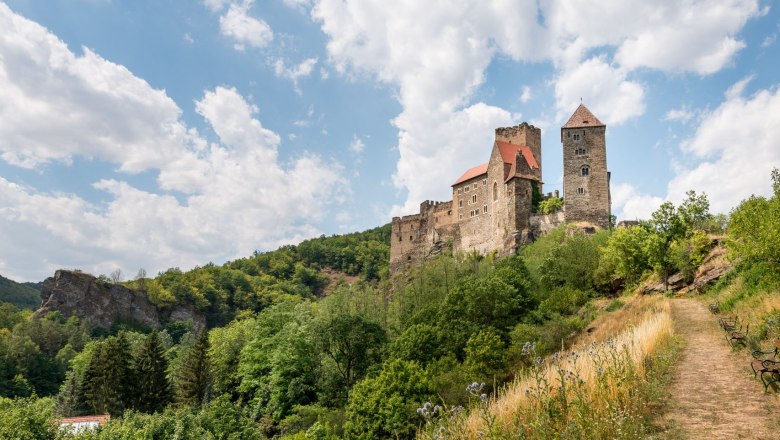Hardegg Castle
The majesty of the Thaya Valley – an imposing eye-catcher.
Enthroned on the promontory overlooking Austria’s smallest town with a municipal charter is one of the largest fortifications in Lower Austria. In the valley landscape of the Thaya River, the towering keep is visible from far and wide. Hardegg Castle (German: Burg Hardegg) on the border with Moravia is like a magnet. All eyes are drawn to it. You experience history at every step within these ancient castle walls. Looking to the east you may well feel the urge to explore the Thaya Valley more thoroughly.
A legacy of the high nobility
The border between Austria and Moravia has always been drawn in the middle of the Thaya – which is probably the reason the fortified castle was built. The first documented mention of it dates from 1140, where it was reported to be a border fortification of Otto of Hardegg. From 1187 onward, it served as the center of power of the Counts of Plain-Hardegg – one of the most significant noble families of the day. The 14th c saw the start of the 200-year rule of the Burgraves of Maidburg. They enlarged the complex, creating twin castles with two chapels in the process. Following the death of Michael of Magdeburg-Hardegg, the castle passed on to the Habsburgs. Emperor Maximilian I then sold it in 1494 to Heinrich Prueschenk, who was subsequently granted the title of Imperial Count of Hardegg. After a fire in 1506, Prueschenk rebuilt the castle. More than a century later, it was sold to the Counts of St. Julien and in 1730 to the Princes Khevenhüller-Metsch. From that point forward, the castle was seldom inhabited and began to fall into decay. The process was helped along by a fire in the town of Hardegg in 1764. The burghers began to remove parts of the castle and use the materials to rebuild their own homes. The complex remained untouched after that for the next 100 years until Johann-Carl Prince Khevenhüller-Metsch set about rebuilding it at the end of the 19th c. Today the castle is owned by Octavian Pilati, son of Marianne Countess of Khevenhüller-Metsch. Besides this castle in Hardegg, he also owns the castle in Ruegersburg.
True knights live differently
The castle is genuinely large in scale, measuring 600 meters in perimeter. The knight’s hall, winter kitchen, smithy, castle chapel, keep and excavation site are all fascinating to explore. On a tour through the historical rooms, you can feel history come alive. Your curiosity grows with every step. What connection does the brother of Emperor Franz Joseph I have with Hardegg? The small museum devoted to Emperor Maximilian of Mexico provides some answers to this question. You are welcome to explore the museum on your own. However, the weapons collection in the armory can only be visited on a guided tour. What more is there to see? You can go down into the old dungeon if you dare. There you feel the dank Middle Ages to the bone.
Mother Nature’s treasure chamber
If you want to continue exploring after a visit to the castle, head for the river bank. The region around Hardegg – the Thaya Valley – is rich in treasures large and small. You can go on excursions to the national park as well as to surrounding towns such as Waidhofen, Dobersberg, Kautzen, Raabs, and Drosendorf or to the Retz region with its abundance of vineyards. Along the way, you will find unspoiled nature, exceptional cycling and hiking tours and incredible castles and fortresses. It doesn't matter which direction you head, just go!
